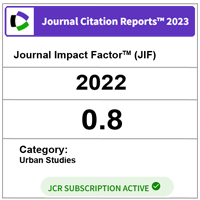Factors Responsible for Slow Adoption of Partnering on Construction Projects in Nigeria
DOI:
https://doi.org/10.11113/ijbes.v5.n1.249Keywords:
Partnering, Slow-adoption, Procurement, Construction practitionersAbstract
Partnering procurement method attracted general acceptance due to potential benefits attached globally. Partnering arrangement was embraced in Nigeria, but the level of implementation is low, the stakeholders hold on to the traditional procurement in spite of its harbored problems. A study that investigated the factors responsible for the slow adoption of partnering in construction in Nigeria is rare. This paper examined factors responsible for the slow adoption of partnering in construction projects execution in Nigeria. This study was conducted using quantitative approach via self-administered questionnaires on construction practitioners (clients, contractors, and consultants) that have handled partnering projects before. The analysis was conducted using descriptive statistic, Kruskal-Walis, and factor analysis. The analysis reveals that there is an agreement in the ranking of twenty-five out of the twenty-nine factors identified. The study discovered that attitudinal and behaviors factor; lack of technical know-how; external, economic, and institutional related factor, procurement related factor, ineffective communication; unethical related issues, and lack of commitment are responsible for low level of implementation of partnering in Nigeria. The study findings would assist the practitioners and decision makers on how to achieve best results from their partnering projects. It would also lead to performance improvement which would subsequently lead to the reaping of benefits. The understanding of these factors would assist the decision maker to plan to tackle it.References
Aarseth, W., Andersen, B., Ahola, T., & Jergeas, G., (2012). Practical difficulties encountered in attempting to implement a partnering approach. International Journal of Managing Projects in Business, Vol. 5(2), pp. 266-284. doi: http://dx.doi.org/10.1108/17538371211214941.
Afolabi, E. Q. (2011). Examining Public Private Partnership in Nigeria: Potentials and challenges. Being A Long Essay Submitted To The Faculty Of Law, University Of Ilorin, Ilorin, Nigeria, In Partial Fulfilment of The Requirement For The Award Of The Degree Of Bachelor Of Law (LL.B Hons) In Common Law.
Akintoye, A. (2015). PPP: Variations and Country Contexts. Keynote address 1 at the Faculty of Environmental Design and Management international conference (EDMIC2015) at Obafemi Awolowo University, Ile-Ife, Nigeria, March.
Akintoye, A., McIntosh, G. and Fitzgerald, E. (2000). A survey of supply chain collaboration and management in the UK construction industry. European Journal of Purchasing & Supply Management, Vol. 6 Nos 3-4, pp. 159-68.
Awodele, O.A., Ogunsemi, D.R. (2010). An Assessment of Success Factors and Benefits of Project Partnering in Nigerian Construction Industry. Published in CIB 2010 World Congress 2010. Published in CIB 2010 World Congress. www.academia.edu/.../ An Assessment_of_ Success_Factors_and_Benefits_of_Project_ Partnering_in_Nigerian_Construction_Industry.
Barlow, J., Cohen, M., Jashapara, A., & Simpson, Y., (1997). Towards positive partnering. The Policy Press, Bristol.
Bayliss, R., Cheung, S. O., Suen, H. C. H., Wong, S. P. (2004). Effective partnering tools in construction: a case study on MTRC TKE contract 604 in Hong Kong. International Journal of Project Management, 22(3):253–63.
Bentler, P.M (1990). Fix indexes, Lagrange multipliers, constraint changes and incomplete data in structure models. Multivariate Behavioural Research. 25(2), 163-172.
Black, C., Akintoye, A., Fitzgerald, E. (2000). An Analysis of Success Factors and Benefits of Partnering in Construction. International Journal of Project Management, 18, 423-434
Bresnen, M.,& Marshall, N., (2000). Partnering in construction: a critical review of issues, problems and dilemmas. Construction Management & Economics; 18(2), pp. 229-237. doi: 10.1080/014461900370852
Chan, A. P. C., Chan, D. W. M., Fan, L. C. N., Lam, P. T. I.,& Yeung, J. F. Y., (2006). Partnering for construction excellence—A reality or myth?. Building Environment, 41(12), pp. 1924–1933. doi:10.1016/j.buildenv.2005.06.026
Chan, A.P.C., Chan, D.W.M., Chiang, Y.H., Tang, B.S., Chan, E.H.W., Ho, K.S.K., (2004). Exploring critical success factors for partnering in construction projects. Journal of Construction Engineering and Management, 130(2), pp. 188–198. DOI: 10.1061/( ASCE) 0733-9364(2004) 130:2(188)
Chan, A.P.C., Chan, D.W.M., Fan, L.C.N., Lam, P.T.I., & Yeung, J.F.Y. (2008). Achieving Partnering Success through an Incentive Agreement: Lessons Learned from an Underground Railway Extension Project in Hong Kong. Journal of Management in Engineering, Vol. 24, No. 3, 128–137.
Chan, A. P. C., Chan, D. W. M., & Ho, K. S.K., (2003). Partnering in construction: critical study of problems for implementation. Journal of Management in Engineering, 19(3), pp. 126–135. DOI: 10.1061 /(ASCE)0742-597X(2003)19:3(126).
Cheung, E., (2009). Developing a best practice framework for implementing public-private partnership (PPPs) in Hong Kong. Unpublished Ph.D. thesis, Queensland University of Technology, Australia.
Cheung, S.O., Ng, S.T., Wong S.P.,& Suen, H.C.H., (2003). Behavioural aspects of construction partnering. International Journal of Project Management. 21(5), pp. 333-343. doi:10.1016/S0263-7863(02)00052-2
Cox, A. and Thompson, L. (1997). Fit for purpose contractual relations: determining a theoretical framework for construction projects, European Journal of Purchasing and Supply Management, Vol.3 (3), pp.127-135
Dikmen, I, Birgonul, M. T, Ozorhon, B. & Eren, K., (2008). Critical success factors for partnering in the Turkish construction industry. In: Dainty, A (Ed) Procs 24th Annual ARCOM Conference, 1-3 September 2008, Cardiff, UK. Association of Researchers in Construction Management, pp.1013-1022.
Egan, J., (1998). Rethinking Construction, HMSO, London.
Eriksson, P.E., Nilsson, T., & Atkin, B., (2008). Client perceptions of barriers to partnering. Engineering, Construction and Architectural Management, Vol. 15(6), pp.527-539, doi: http://dx.doi.org/10.1108/09699980810916979.
Fellows, R. F., and Liu, A. M. M. (2015). Research Methods for Construction, 4th Edition. John Wiley & Son Ltd publishing
Glagola, C.R., & Sheedy, W.M., (2002). Partnering on defense contracts. Journal of Construction Engineering and Management, 128 (2), pp.127–138. doi:http://dx.doi.org/10.1061/(ASCE)0733-9364(2002)128:2(127)
Hasanzadeh, S.M., Mujtaba Hosseinalipour, M.,& Mohammad Reza Hafezi, M.R. (2014).
Collaborative procurement in construction projects performance measures, Case Study: Partnering in Iranian construction industry. Procedia - Social and Behavioral Sciences 119 (2014) pp.811 – 818
Hong, Y., Chan, D. W. M., & Chan, A.P.C., (2012). Exploring the applicability of construction partnering in Mainland China. Facilities, 30 (13/14), pp. 667 – 694. DOI:http://dx.doi.org/10.1108/02632771211270603
Iboh, A.A., Adindu, C. C., Oyoh, A. J.(2013). Public Private Partnership Construction Project Disputes in Nigeria. Journal of Research in National Development Vol. 11(1), pp. 1-11.
Kadiri, D.S., Ojo, S.O., & Jagboro, G.O., (2015). Implications of adopting public-private partnership for infrastructure development in Nigeria. Journal of Sustainable Development; Vol. 8, No. 9; pp 169-177. doi: http://dx.doi.org/10.5539/jsd.v8n9p169
Kaluarachchi, Y. D., and Jones, K. (2007). Monitoring of a Strategic Partnering Process: the Amphion experience. Constr. Manage. Econo. 25(10): 1053-1061.
Koraltan, S.B. and Dikbas, A., (2002). An assessment of the applicability of partnering in the Turkish construction sector. Construction Management and Economics, Vol. 20(4), pp. 315-321. doi:10.1080/01446190210125554
Kwan, A.Y. and Ofori, G. (2001). Chinese culture and successful implementation of partnering in Singapore's construction industry. Construction Management Economics, Vol. 19(6), 619-632
Larson, E., (1995). Project partnering: results of a study of 280 construction projects. Journal of Management in Engineering, 11 (2), pp. 30-35. DOI: http://dx.doi.org/10.1061/(ASCE)0742-597X(1995)11:2(30)
Larson, E., & Drexler, J.A., (1997). Barriers to project partnering: Report from the Firing Line. Project Management Journal, 28(1), pp.46-52
Lazar, F.D., (1997). Partnering-new Benefits from Peering inside the Black Box. Journal of Management in Engineering. 13(6), pp. 75-83. Doi: http://dx.doi.org/10.1061/(ASCE)0742-597X(1997)13:6(75)
Le-Hoai, L., Lee, Y. D., & Son, J. J., (2010). Partnering in construction: investigation of problematic Issues for Implementation in Vietnam. KSCE Journal of Civil Engineering, 14(5), pp.731-741. Doi:10.1007/s12205-010-0916-8
Loraine, R.K. (1994). (1994) Project specific partnering. Engineering, Construction and Architectural Management, Vol. 1 Issue: 1, pp.5-16, doi.org/10.1108/eb020989
Meng, X., (2012). The effect of relationship management on project performance in construction. International. Journal of. Project. Management. International Journal of Project Management 30 (2012) 188–198 http://dx.doi.org/10.1016/j.ijproman. 2011.04.002.
Moore, C., Mosley, D., and Slagle, M. (1992) Partnering guidelines for win-win project management. Project Management Journal 22(1): 18–21.
Ng, S.T., Rose, T.M., Mak, M. and Chen, S.E., 2002. Problematic issues associated with project partnering – the contractor perspective. International Journal of Project Mgmt. 20: 437–449. doi:10.1016/S0263-7863(01)00025-4
Ogunsanya, O. A., Aigbavboa, C. O. & Thwala, D.W. (2016). Challenges Of Construction Procurement: A Developing Nation’s Perpespective. International Conference of Socio-economic Researchers ICSR 2016 SERBIA. Conference Proceedings. pp 205- 217.
Ogunsemi, D. R., Oyediran, S. O. & Ekundayo, D.O. (2008). Construction professionals and project management competencies in Nigeria. Journal of Construction, 1(2): 6–11.
Okereke, O. C., 2007. Project management: A strategic instrument for effective political governance and economic development. PM World Today, 9(6), pp.1– 17.
Oluwaseun, O. & Odun, O., (2014). Public private partnership and Nigerian economic growth: Problems and Prospects. International Journal of Business and Social Science, 5(11), pp. 132-139.
Opawole, A., Jagboro, G.O., (2016). Benchmarking parties’ obligations in the execution of concession-based PPP projects in Nigeria. Journal of Place Management and Development, 9(1), pp. 27-46. DOI: http://dx.doi.org/10.1108/JPMD-08-2015-0029
Pallant, J., (2010). SPSS Survival Manual: A step by step guide to data analysis using SPSS for Windows, McGraw Hill, New York, NY.
Rattray, J. & Jones, M. C., (2007). Essential elements of questionnaire design and development. Journal of Clinical Nursing, 16(2), pp.234-243. DOI: 10.1111/j.1365-2702.2006.01573.x
Sorrell, S., (2003). Making the link: climate policy and the reform of the UK construction industry. Energy Policy, 31(9), pp. 865-878. doi:10.1016/S0301-4215(02)00130-1
Stralkowski, C.M.,& Billon, S.A., (1988). Partnering: a strategic approach to productivity improvement. National Productivity Review, 7, pp.145-151. DOI: 10.1002/npr.4040070206
Tabachnick, B. G. & Fidell, L. S., (2007). Using multivariate statistics. 5th edition. Boston: Pearson/Allyn & Bacon.
Tang, W., Duffield, C. F, & Young, D. M. (2006 ). Partnering Mechanism in Construction: An Empirical Study on the Chinese Construction Industry. Journal of Construction Engineering and Management, Vol. 132, No. 3, pp. 217–229
Yang, J. B., Yang, C. C., & Kao, C.K. (2010). Evaluating schedule delay causes for Private Participating Public Construction Works under the Build-Operate-Transfer Model. International Journal of Project Management, Vol. 28, pp. 569-579. DOI:10.1016/j.ijproman.2009.10.005
Yuan, J., Zeng, A. Y., Skibniewski, M.J. & Li, Q., (2009). Selection of performance objectives and Key Performance Indicators in Public–Private Partnership Projects to Achieve Value for Money. Construction Management and Economics, 27(3), pp.253-270, DOI: 10.1080/01446190902748705
Zuo, J., Chan, A., Zhao, Z., Zillante, G., & Xia, P., (2013). Supporting and impeding factors for partnering in construction – a China study. Facilities. 31(11-12), pp. 468-488. DOI: http://dx.doi.org/10.1108/F-05-2012-0038
Downloads
Published
How to Cite
Issue
Section
License
Copyright of articles that appear in International Journal of Built Environment and Sustainability belongs exclusively to Penerbit Universiti Teknologi Malaysia (Penerbit UTM Press). This copyright covers the rights to reproduce the article, including reprints, electronic reproductions or any other reproductions of similar nature.
Authors who publish with this journal agree to the following terms:
- This Journal applies Creative Commons Licenses of CC-BY-NC-SA
- Authors retain copyright and grant the journal right of publication with the work simultaneously licensed under a Creative Commons Attribution License that allows others to share the work with an acknowledgement of the work's authorship and publication in this journal.
- Authors are able to enter into separate, additional contractual arrangements for the non-exclusive distribution of the journal's published version of the work (e.g., post it to an institutional repository or publish it in a book), with an acknowledgement of its publication in this journal.
- Authors are permitted and encouraged to post their work online (e.g., in institutional repositories or on their website) prior to and during the submission process, as it can lead to productive exchanges, as well as earlier and greater citation of published work (See The Effect of Open Access).







